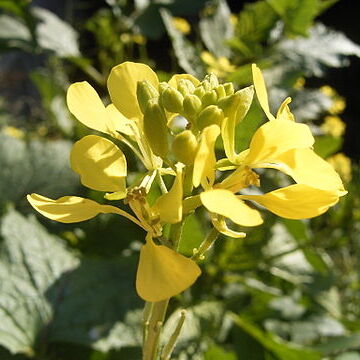Herbs annual or rarely perennial. Trichomes absent or simple. Stems erect or ascending, often branched apically, leafy. Basal leaves petiolate, not rosulate, simple, lyrate, pinnatifid, pinnatisect, bipinnatisect or/and dentate. Cauline leaves petiolate or sessile, not auriculate, entire, dentate, or shallowly lobed. Racemes ebracteate, elongated considerably in fruit. Fruiting pedicels slender or thickened, erect, ascending, divaricate, or reflexed. Sepals oblong or linear, spreading or reflexed, not saccate. Petals yellow, spreading; blade obovate, apex obtuse or emarginate; claw subequaling sepals. Stamens 6, tetradynamous; anthers oblong, obtuse at apex. Nectar glands 4, distinct; median pair ovoid; lateral pair prismatic, flat, or rarely lobed. Ovules 4-20 per ovary. Fruit dehiscent siliques, linear, lanceolate, or oblong, terete, somewhat 4-angled, or latiseptate, sessile, segmented; valvular segment dehiscent, few to many seeded, longer or shorter than terminal segment, torulose; valves with 3-7, prominent, longitudinal veins, thin or thick and obscurely veined; terminal segment indehiscent, seedless or 1-or 2-seeded, flattened and ensiform, or terete and conical or subulate, sometimes corky; replum rounded; septum complete, membranous; style distinct; stigma capitate, 2-lobed. Seeds uniseriate, wingless, globose, plump or rarely slightly flattened; seed coat reticulate, mucilaginous or not when wetted; cotyledons conduplicate.
Annual, sometimes perennial, taprooted herbs. Hairs simple, often bristly. Stems erect, leafy. Lvs lyrate-pinnate, lyrate-pinnatifid, or not lobed; margins toothed. Racemes ebracteate. Sepals spreading, not saccate. Petals yellow. Stamens 6, without appendages. Lateral nectaries 2, inside the bases of the single stamens; median nectaries 2, outside each median pair of stamens. Stigma sessile, shortly 2-lobed. Silique narrow-lanceolate to linear, dehiscent; valves distinctly 3-(7)-veined; beak tapering, weakly to strongly flattened, 0-9-seeded. Seeds spherical, not winged, in 1 row per locule.
Annual herb, erect, branched. Inflorescence without bracts. Sepals non-saccate, spreading. Petals shortly clawed, yellow. Stamens 6. Nectariferous glands 4; the lateral 2 inside the filaments; median 2 between long filaments, outside. Siliqua dehiscent, cylindrical, beaked; beak usually flattened, usually 1-seeded; valves 3–7-veined. Seeds spherical, 1 row per locule, brown; cotyledons conduplicate; radicle incumbent.
Much like Brassica, but the valves of the fr with 3–5 prominent veins; beak 3-nerved on each side, often flattened and 2-edged (ensiform), often with 1–3 seeds; sep spreading to reflexed. 7, Mediterranean.
Silique terete, with convex valves, each 3–7-nerved, and a long beak with 0–4-(9) seeds.
Herbs, usually annual, with simple hairs.
Seeds 1-seriate, subspherical.
Sepals spreading, not saccate.
Cotyledons conduplicate.
Stigma somewhat 2-lobed.
Petals 4, unguiculate.
Flowers yellow.
Stamens 6.

